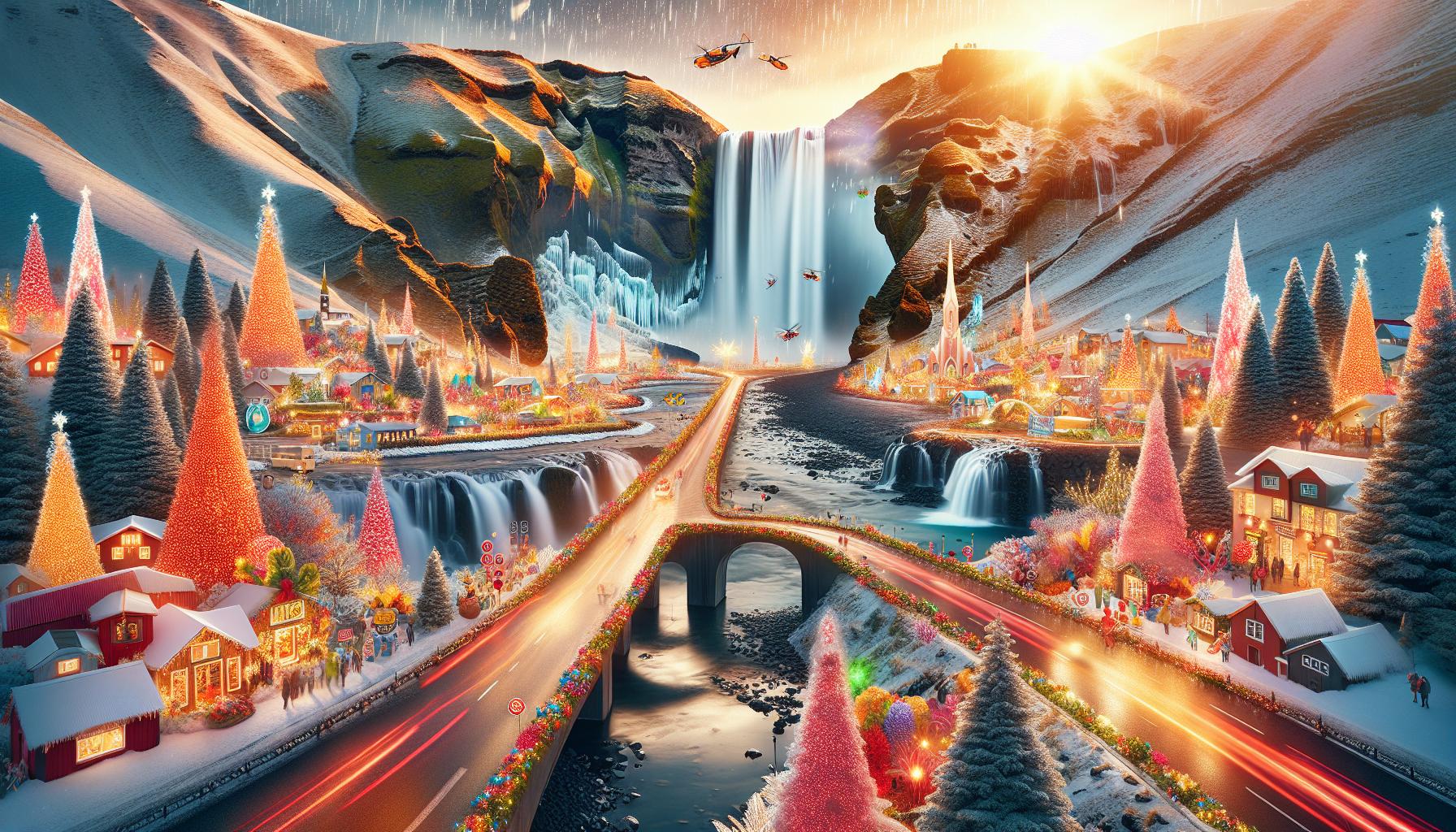Embarking on a journey around Iceland’s iconic Ring Road offers breathtaking landscapes and unforgettable experiences, but how long does this epic drive actually take? Understanding the duration helps travelers plan their adventures efficiently, ensuring they don’t miss spectacular sights like waterfalls and glaciers. Typically, a full circuit can take about 7 to 14 days, depending on stops.
Understanding the Ring Road: An Overview of Iceland’s Iconic Route

Exploring the captivating landscapes of Iceland is best achieved by embarking on the country’s famed Ring Road. This iconic route, known as Route 1, spans approximately 800 miles and provides travelers with the opportunity to witness a diverse array of natural wonders. From dramatic volcanic landscapes to serene coastal fjords, the journey offers a unique glimpse into Iceland’s stunning beauty that keeps visitors returning season after season.
One of the most appealing aspects of the Ring Road is its accessibility and the remarkable variety of sights along the way. Travelers can experience everything from thundering waterfalls and bubbling geothermal springs to the captivating charm of small fishing villages. This scenic highway circles the entire island, connecting key regions including South Iceland, East Iceland (Austurland), and North Iceland. Due to the multitude of attractions, it’s essential to plan your trip wisely to maximize your experience and truly understand how long it takes to drive Ring Road Iceland.
Key Attractions Along the Ring Road
As you traverse the Ring Road, numerous must-see destinations await. Here are a few highlights:
- Reykjavík: Iceland’s vibrant capital, known for its unique architecture and lively culture.
- Golden Circle: Home to Geysir, Gullfoss Waterfall, and Þingvellir National Park, a UNESCO World Heritage site.
- Skaftafell National Park: Offers stunning glacier views and hiking trails.
- Jökulsárlón Glacier Lagoon: Famous for its floating icebergs, this lagoon is a photographer’s paradise.
- Akureyri: Often referred to as the “Capital of the North,” it’s surrounded by beautiful fjords.
It’s wise for travelers to pace their journey. While the drive around the Ring Road can typically be completed in about 17-20 hours of actual driving time, the unique attractions and scenic vistas encourage a more leisurely exploration. Given the fluctuating weather and road conditions, particularly in winter, it’s advisable to factor in additional time for stops to truly soak in the mesmerizing landscapes.
Travel Tips for the Ring Road Journey
To fully embrace the experience of driving the Ring Road, consider these actionable tips:
- Plan your stops: Identify key attractions ahead of time and plot them into your itinerary.
- Check road conditions: Stay updated via the Icelandic Road and Coastal Administration’s website.
- Be mindful of daylight: In summer, enjoy extended hours of daylight, while winter days are shorter.
- Pack snacks and water: While there are places to stop, having supplies can be handy during longer stretches.
Understanding the essence of how to navigate the Ring Road profoundly enhances your journey in Iceland. By recognizing its significance and preparing effectively, travelers can create unforgettable memories amidst one of the most beautiful backdrops in the world.
The Best Time of Year to Drive the Ring Road: Seasonal Insights
Driving the Ring Road of Iceland is an adventure that rewards travelers with breathtaking views and unique landscapes. However, choosing the right time of year to embark on this journey can dramatically affect your experience. Each season in Iceland offers distinct landscapes and varying conditions that can enhance or hinder your travel plans.
Spring (April to June)
Spring is an exceptional time to explore the Ring Road, as the weather begins to warm and the landscapes turn vibrant. Late April marks the melting of winter ice and snow, unveiling lush greenery and blooming wildflowers. Many attractions start to reopen, making it easier to access stunning sites like waterfalls and geothermal areas. Travelers can enjoy longer daylight hours and relatively mild conditions. The average temperature ranges from 0°C to 10°C (32°F to 50°F), making it a refreshing yet manageable time for road trips.
- Pros: Fewer tourists, blooming landscapes, increased accessibility.
- Cons: Varying weather conditions and some highland roads may still be closed.
Summer (June to August)
Summer is the peak season for driving the Ring Road, offering the best weather and accessibility. With nearly 24 hours of daylight, you can maximize your time at various attractions. Summer temperatures can reach up to 15°C to 25°C (59°F to 77°F), ideal for outdoor activities such as hiking and camping. However, expect larger crowds and higher accommodation prices. This season is perfect for those wanting to experience Iceland’s vibrant culture, festivals, and wildlife, particularly during whale watching tours.
- Pros: Great weather, lively atmosphere, and maximum accessibility.
- Cons: Crowds and higher costs.
Autumn (September to October)
Autumn offers a unique blend of experiences, characterized by stunning fall foliage and a slower pace as the tourist season winds down. The temperatures begin to drop, ranging from 5°C to 15°C (41°F to 59°F), creating a picturesque backdrop as the leaves change color. This is also an ideal time for photographers, as the landscapes take on a dramatic quality, particularly around the golden hours. However, as you head into late October, winter conditions may start to set in, limiting some accessibility.
- Pros: Fewer tourists, stunning scenery, and the chance to see the Northern Lights beginning in late September.
- Cons: Shorter days and unpredictable weather.
Winter (November to March)
Driving the Ring Road in winter is a completely different experience, offering a magical landscape of snow and ice. While the scenery can be breathtaking, be prepared for harsh weather conditions, with temperatures averaging between -5°C to 5°C (23°F to 41°F). Many highland roads are closed, and driving can be challenging due to snow and ice. However, this season attracts those keen to see the Northern Lights and enjoy winter activities like glacier hiking and snowmobiling.
- Pros: Fewer tourists, the chance to witness the Northern Lights, and unique winter activities.
- Cons: Road conditions can be treacherous and limited daylight hours.
Planning your journey based on the season can make a significant difference in how you experience the Ring Road. Whether you aim to see Iceland’s summer landscapes, enjoy autumn hues, or witness the winter wonderland, each season offers its own charm. For more detailed advice on driving the Ring Road and planning your itinerary, refer to the comprehensive guide on How Long Does It Take to Drive Ring Road Iceland: Complete Guide.
Must-See Stops Along the Ring Road: From Waterfalls to Volcanic Landscapes

Exploring Iceland’s Ring Road is an adventure unlike any other, taking you through a diverse tapestry of breathtaking natural landscapes. From thundering waterfalls to vibrant volcanic craters, this drive offers an abundance of must-see stops that capture the essence of Iceland’s stunning beauty. Each stop along the route not only showcases unique geographical features but also immerses you in the rich culture and history of the region.
Iconic Waterfalls
One of the highlights of the journey is undoubtedly the impressive waterfalls. Skógafoss and Gullfoss are two of the most celebrated cascades, each offering a different yet equally captivating experience. Skógafoss, with its 60-meter drop, creates a constant mist that often results in rainbows on sunny days, making it perfect for photography enthusiasts. Meanwhile, Gullfoss, known as the “Golden Falls,” is renowned for its multi-layered structure and the roaring sound of its water, which plunges in two stages into a rugged canyon.
- Skógafoss: Accessible via the South Coast, this stunning waterfall has a majestic view and historical significance.
- Gullfoss: Part of the Golden Circle, it offers incredible viewpoints and a visitor center nearby.
Majestic Volcanic Landscapes
In addition to its waterfalls, Iceland’s Ring Road presents a series of dramatic volcanic landscapes that tell the geological story of the island. Eyjafjallajökull, the volcano that famously disrupted air travel in 2010, is a remarkable sight, particularly when viewed from below its glacial cap. Travelers can also visit the Fjallabak Nature Reserve, where hikers can explore colorful rhyolite mountains, hot springs, and ancient lava fields.
Table of Must-See Volcanic Sites
| Volcanic Site | Highlights |
|---|---|
| Eyjafjallajökull | Stunning views, glacial rivers, and hiking trails. |
| Fjallabak Nature Reserve | Colorful mountains, hot springs, and diverse flora. |
Whether you’re enchanted by the rushing waters or captivated by the rugged terrain shaped by volcanic activity, each stop reveals a different chapter in Iceland’s natural history. To truly appreciate how long it takes to drive the Ring Road, consider allocating ample time for these stops, ensuring you don’t miss out on the breathtaking vistas and enriching experiences that make this journey one of the most memorable road trips in the world.
Planning Your Itinerary: How Many Days Do You Need?

The breathtaking landscapes and unique geological features of Iceland attract visitors from around the globe, making a journey along the Ring Road a bucket-list adventure. To appreciate this stunning route fully, careful planning is essential, particularly when it comes to determining how many days you should allocate for your trip.
For those aiming to drive the entire Ring Road, it is recommended to set aside a minimum of seven days. This timeframe allows you to experience the major highlights without feeling rushed. Some must-see destinations include the Golden Circle, with its geothermal wonders, and the picturesque falls like Skógafoss. If you wish to savor Iceland’s diverse landscapes, consider extending your itinerary to ten days or more. This additional time enables deeper exploration, such as whale watching, glacier hiking, and soaking in the Blue Lagoon.
Additionally, many travelers opt for a 12-day itinerary. This extended schedule provides ample opportunity to traverse the more remote and scenic areas of the country, such as the East Fjords and the Snæfellsnes Peninsula. The following table outlines a suggested itinerary framework, ensuring you hit the key attractions while allowing for spontaneity and relaxation:
| Day | Key Stops | Activities |
|---|---|---|
| 1 | Reykjavík | Explore the city, visit Hallgrímskirkja |
| 2 | Golden Circle | Geysir, Gullfoss, Þingvellir National Park |
| 3 | South Coast | Skógafoss, Seljalandsfoss, Reynisfjara Beach |
| 4 | Vik to Höfn | Black sand beaches, Vatnajökull National Park |
| 5 | East Fjords | Scenic drives, small fishing villages |
| 6 | North Iceland | Akureyri, Lake Mývatn, Dettifoss |
| 7 | West Iceland | Snæfellsnes Peninsula, Kirkjufell |
| 8 | Reykjavík | Return to city, relax at Blue Lagoon |
When planning your itinerary, always factor in the weather and road conditions, as these can significantly affect travel times. Remember, the goal is to enjoy the journey, taking in the beauty that defines Iceland’s Ring Road. Ultimately, how long it takes to drive the Ring Road in Iceland depends on your interests and how much time you wish to spend on each breathtaking site.
Navigating Icelandic Weather: Driving Safely in Unpredictable Conditions

Driving in Iceland offers breathtaking views, but the changing weather conditions can be a driver’s worst enemy. With its dramatic landscapes and unique geographical features, the island experiences rapid weather fluctuations that can turn a scenic drive into a challenging adventure. Understanding how to adapt to these conditions is crucial for a safe and enjoyable experience on the Ring Road.
Understanding Weather Patterns
Iceland’s weather is notorious for its unpredictability; the saying goes, “If you don’t like the weather, wait five minutes.” Factors such as elevation, proximity to the coast, and even time of year can dramatically influence conditions. When planning your drive around the Ring Road, it is essential to check forecasts regularly, as weather can vary significantly from one region to another.
- Spring (April – June): Variable conditions with melting snow but still cold. Be wary of icy patches, especially in the north.
- Summer (July – August): Generally mild temperatures; however, rain showers are common. Ideal for long drives.
- Autumn (September – November): Rapid temperature drops and increased rainfall. Prepare for snow in higher altitudes.
- Winter (December – March): Heavy snowfall and icy roads can make driving hazardous. Always check road conditions.
Essential Driving Tips
To navigate the often fickle Icelandic weather safely, follow these practical driving tips:
- Check Road Conditions: Before setting off, visit the Icelandic Road and Coastal Administration website. Here, you can find live updates on road conditions and any closures that may impact your route.
- Adjust Your Speed: In hazardous conditions such as icy roads or heavy rain, reduce your speed significantly. These adjustments provide you with more time to react to unexpected obstacles.
- Stay Aware: Use local weather apps and services that provide real-time updates. Following weather patterns can allow for strategic stops along the Ring Road, optimizing both safety and enjoyment.
- Vehicle Preparedness: Ensure your vehicle is equipped for diverse conditions. This includes carrying a spare tire, extra warm clothing, and emergency supplies, which can be lifesavers if you find yourself stranded.
Impact of Weather on Travel Time
Weather can play a significant role in how long it takes to drive the Ring Road. Here’s a simple overview of how various conditions can impact your travel time:
| Weather Condition | Estimated Impact on Travel Time |
|---|---|
| Clear Skies | Travel time as expected |
| Rain | +10-15% increase in travel time |
| Snow/Ice | +30-50% increase (or more) |
| Fog | +20-30% increase in travel time |
Being mindful of these factors will not only enhance your safety but also ensure that you can experience the true beauty of Iceland without unnecessary stress. As you embark on your journey along the Ring Road, prepare for unexpected challenges, and keep the awe-inspiring scenery as your ultimate destination.
Local Tips for a Memorable Journey: Food, Accommodation, and Culture
Exploring the Ring Road in Iceland is not just about the stunning landscapes, but also about immersing yourself in local culture, tasting traditional cuisine, and finding the perfect spot to rest your head after a long day of adventure. With intelligent planning, your journey can be profoundly enriched. Here’s how to make the most of your Icelandic experience, ensuring it’s memorable and authentic while navigating How Long Does It Take to Drive Ring Road Iceland: Complete Guide.
Delicious Stops Along the Way
Food in Iceland reflects its unique geography and culture. Make sure to sample some local delicacies as you traverse the Ring Road. Here are a few must-try options:
- Lamb Soup: A hearty dish perfect for warming you up after a long day. Try it at any roadside café, especially in the South.
- Skyr: This traditional Icelandic yogurt is creamy and packed with protein, making it a great snack on the go.
- Fish & Chips: Found in many coastal towns, this dish is freshly caught, crunchy, and delightful!
- Hot dogs: Don’t miss the famous Bæjarins Beztu Pylsur food truck in Reykjavik for an iconic Icelandic hot dog.
Comfortable and Unique Accommodations
Finding the right place to stay is crucial for relaxing during your journey. The Ring Road offers a variety of accommodations ranging from boutique hotels to cozy guesthouses and even campgrounds. Here are some options:
| Type of Accommodation | Location Examples | Unique Features |
|---|---|---|
| Guesthouses | Vik, Egilsstaðir | Homey feel, often includes local breakfast. |
| Hotels | Akureyri, Reykjavik | Modern amenities, central locations. |
| Camping | National Parks, remote areas | Closer to nature, great for stargazing. |
Engaging with Local Culture
To fully appreciate Iceland beyond its iconic landscapes, dive into local culture and customs. Here are a few suggestions to enhance your experience:
- Visit a Local Market: Check out the different farmers’ markets for fresh produce and homemade goods. Each region has its own staple items!
- Participate in Festivals: If your timing allows, enjoy events like the Reykjavik Culture Night or the Iceland Airwaves Music Festival to connect with locals and their traditions.
- Learn a Few Icelandic Phrases: Even a simple “Takk fyrir!” (Thank you!) can go a long way in making connections.
Whether you are savoring traditional dishes, resting in unique lodgings, or engaging with the vibrant culture, your journey around the Ring Road will be enhanced with these local insights, adding depth beyond the scenic views. Enjoy the adventure!
Fueling Your Adventure: Where to Refuel and Recharge Along the Way
Driving the Ring Road in Iceland is a thrilling adventure, and knowing where to fuel both your vehicle and yourself is crucial for an enjoyable journey. With its spectacular landscapes and countless attractions, planning where to refuel is essential to ensure you don’t miss out on the stunning scenery or essential services.
Gas Stations Along the Ring Road
Gas stations are strategically located along the Ring Road, but it’s wise to keep an eye on your fuel gauge. Here are some tips for managing fuel stops:
- Most major towns along the route, such as Reykjavík, Akureyri, and Vik, have fully serviced gas stations.
- Out in the countryside, stations may be less frequent, and some may operate with limited hours, particularly outside peak tourist seasons.
- Self-service stations are common, and many accept credit cards, but ensure your card works in Iceland; not all international cards may be accepted.
- Consider filling up whenever you have the chance, especially after visiting remote attractions or locations.
Dining and Rest Stops
In addition to fuel, the Ring Road offers numerous opportunities to refuel your body. Every major town will have a variety of dining options, ranging from local delicacies to international cuisine. Make sure to try some traditional Icelandic dishes, such as lamb soup or freshly caught seafood, to enhance your culinary adventure.
You’ll also find rest areas equipped with amenities. Key locations to take a break include:
| Location | Fuel Availability | Dining Options |
|---|---|---|
| Reykjavík | Yes | Numerous restaurants |
| Akureyri | Yes | Cafés and diners |
| Vik | Yes | Local eateries |
| Egilsstaðir | Yes | Fast food and Icelandic cuisine |
When planning your journey along the Ring Road, incorporate these refueling stops into your itinerary. This not only prevents discomfort but also enriches your experience as you explore the breathtaking vistas of Iceland. It’s all part of the adventure – knowing how long it takes to drive the Ring Road in Iceland means also understanding the importance of regular breaks to enjoy the journey fully.
Exploring Off the Beaten Path: Hidden Gems Near the Ring Road
Iceland is a land of stunning contrasts, and while the Ring Road itself is a magnificent journey through the heart of this island nation, some of its most enchanting experiences lie just off the route. Venture beyond the main highways, and you’ll discover hidden gems that offer a more intimate and unique view of Iceland’s natural beauty. Exploring these off-the-beaten-path locations can transform your trip into an unforgettable adventure.
Discovering Secluded Waterfalls
While iconic sites like Gullfoss and Seljalandsfoss attract throngs of visitors, lesser-known waterfalls provide a more tranquil experience. For instance, Haifoss, one of Iceland’s tallest waterfalls, is tucked away in a dramatic canyon in Þjórsárdalur valley. A hike to Haifoss rewards you with breathtaking views and the chance to enjoy the peaceful surroundings without the usual crowds. Similarly, Múlagljúfur Canyon, near Vatnajökull National Park, boasts stunning waterfalls and rugged cliffs, perfect for a serene hike.
Impressive Geothermal Features
Iceland is renowned for its geothermal activity, and while places like the Blue Lagoon are famous, hidden hot springs beckon for exploration. Secret Lagoon in Flúðir offers a more authentic and less commercialized experience. Surrounded by exquisite natural beauty, this spot allows visitors to soak in geothermal waters amidst bubbling hot springs. For a true adventure, seek out Reykjadalur Hot Springs, where a scenic hike leads you to a natural hot river—perfect for relaxing after your trek.
Cultural Insights and Local Experiences
Venturing away from the main tourist areas allows for deeper cultural connections. Visit Þingeyrar, a historic site that was once the location of Iceland’s first parliament. Here, you can explore ancient ruins and gain insight into the country’s early governance. Additionally, Seyðisfjörður, a picturesque village in East Iceland, is known for its vibrant arts scene and charming wooden houses. Spending time here offers a glimpse into local life and artistic expression, enriched by the dramatic backdrop of surrounding mountains.
By incorporating these less-traveled paths into your journey along the Ring Road, you can elevate your Icelandic adventure. From breathtaking landscapes to cultural insights, these hidden gems provide a richer experience that captures the true essence of this remarkable island. Whether you’re drawn to secret waterfalls, soothing hot springs, or quaint villages, taking time to explore beyond the main route can reveal a side of Iceland that many miss.
Faq
How long does it take to drive Ring Road in Iceland?
Driving the Ring Road in Iceland typically takes about 17 to 20 hours of driving time without extended stops. However, for a more enjoyable experience, many travel recommend allocating between 7 to 14 days to fully explore the stunning landscapes, waterfalls, and national parks.
The journey spans approximately 1,332 kilometers (828 miles) around the country. This allows ample time for scenic stops, such as the breathtaking Seljalandsfoss waterfall and the iconic Jökulsárlón Glacier Lagoon. With countless attractions, focusing solely on the driving time would be a missed opportunity.
What is included in the Ring Road Iceland: Complete Guide?
The complete guide typically covers essential information like driving times, must-see attractions, safety tips, and recommendations for accommodations and dining along the way. This comprehensive approach helps create a well-planned itinerary tailored to your interests.
You’ll find details on the best travel seasons, road conditions, and local culture, alongside practical advice for navigating Iceland’s stunning yet challenging landscapes. By including personal stories and insider tips, such a guide enriches your adventure and ensures you’re well-prepared for a memorable journey.
Can I drive the Ring Road in winter?
Yes, you can drive the Ring Road in Iceland in winter, but it’s essential to prepare for challenging conditions. Winter weather can significantly affect road conditions and visibility, making a 4WD vehicle a wise choice.
Be aware of shortened daylight hours and always check road conditions and weather forecasts before heading out. Many travelers enjoy the serene beauty of a snow-covered landscape, but driving responsibly is crucial. Check out our tips for winter driving in Iceland to stay safe on your adventure.
Why does the driving time vary for the Ring Road in Iceland?
The driving time for the Ring Road in Iceland can vary due to various factors, including road conditions, weather, and individual travel preferences. While the route is straightforward, Iceland’s often unpredictable weather can extend travel times significantly.
Additionally, if you plan frequent stops to explore breathtaking sites like Reykjavik or the Skaftafell National Park, your overall travel time will increase. Planning ahead and allowing flexibility in your itinerary helps ensure a more enjoyable journey.
What are the best attractions along the Ring Road?
Some of the must-see attractions along the Ring Road in Iceland include the stunning Golden Circle, Gullfoss waterfall, and the geothermal area of Geysir. Exploring national parks like Þingvellir and locations like Akureyri adds to the adventure.
Each stop along the Ring Road offers unique experiences, from black sand beaches in Vik to the wildlife-rich Snæfellsnes Peninsula. Consider how diverse these attractions make the journey, turning each day into a new exploration of Iceland’s captivating landscapes.
How do I plan my trip around the Ring Road?
Planning a trip around the Ring Road in Iceland involves setting a timeframe, selecting accommodations, and mapping out attractions that interest you. Allow time for both major sites and hidden gems to get a true taste of Iceland’s beauty.
Make use of online resources, like travel blogs and forums, to gather insights and share experiences from other travelers. Utilizing online maps can help effectively plot your course, ensuring a smooth journey filled with captivating discoveries.
What should I pack for driving the Ring Road in Iceland?
When driving the Ring Road in Iceland, pack layers of clothing to accommodate varying weather conditions. Essential items include a warm, waterproof jacket, hiking boots, and a good camera to capture breathtaking landscapes.
Don’t forget to bring a travel guide, snacks, and a reusable water bottle. Familiarizing yourself with Iceland’s driving laws and conditions is also vital, ensuring that you’re well-prepared for your adventure. Read our full packing checklist for Iceland to ensure you’re ready.
To Wrap It Up
Wrapping up your journey along Iceland’s enchanting Ring Road, it’s clear that this isn’t just a drive; it’s an unforgettable experience waiting to unfold. Whether you’re mesmerized by the cascading waterfalls of the South or the dramatic fjords of the North, each stop along the way is packed with breathtaking scenery and rich cultural tales.
Take your time—while you can drive the Ring Road in about 17-20 hours without stops, allowing for leisurely exploration can transform your trip into a memorable adventure. Imagine stopping for a warm cup of coffee in a cozy seaside town or chatting with locals sharing stories of their Viking heritage.
We encourage you to embrace the road less traveled, indulge in spontaneous detours, and fully immerse yourself in the vibrant landscapes and unique experiences that Iceland offers. With its blend of serene nature and captivating history, your journey on the Ring Road promises to be filled with endless discoveries and heartwarming moments.
So pack your bags, grab your camera, and get ready to create lasting memories in this land of fire and ice. Your Icelandic adventure awaits!






